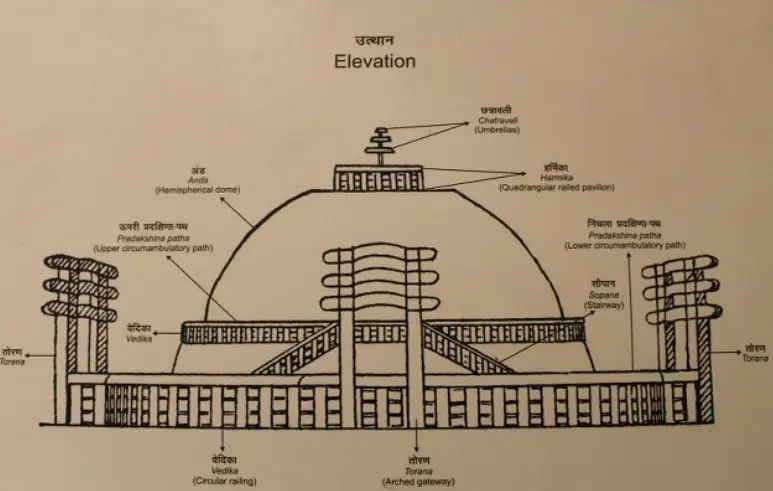Mauryan Art and Architecture
Introduction
Mauryan art and architecture experienced a vibrant period from the 4th to the 2nd century BCE, corresponding to the duration of the Mauryan dynasty, which thrived from 322 BCE to 185 BCE. The distinctive features of Mauryan art and architecture included the construction of pillars, stupas, and viharas. The pillars, crafted from sandstone, stood out as a signature element of Mauryan artistic expression, adorned with inscriptions of Emperor Ashoka's edicts. Stupas, substantial dome-shaped structures, served as Buddhist shrines, while viharas functioned as residential dwellings for Buddhist monks. The predominant medium for Mauryan art was sculpture, with a notable emphasis on the development of the art of stone carving during this period.
- Shramana tradition: Jainism and Buddhism emerged around 6th century BCE
- Mauryas established as a major power by 4th century BCE, controlling large parts of India by the 3rd century
- Diverse religious practices during this time, including worship of Yakshas and mother-goddesses
- Buddhism became the most popular among various religious modes
- Monumental stone sculpture and architecture appeared primarily during the Mauryan period after the Harappan civilization
- Notable features include pillars, sculptures, rock-cut architecture, stupas, viharas, and chaityas
- Structures served multiple purposes and exhibited exquisite aesthetic quality in design and execution
Mauryan Pillars and Sculptures
- Pillar erection was a common practice in the Achamenian Empire (Persian Empire), sharing similarities with the Mauryan Empire such as the use of polished stones and motifs like the lotus. However, notable differences exist, as Achamenian pillars were constructed in pieces, while Mauryan pillars were rock-cut, showcasing the exceptional skill of the carver.
- Stone pillars adorned the Mauryan Empire, featuring inscribed proclamations used by Emperor Ashoka to propagate the Buddha's message. These pillars were distributed throughout the empire.
- The upper part of the pillar, known as the capital, typically showcased animal figures like bulls, lions, elephants, etc., standing on a square or circular abacus. The abacus, in turn, rested on the base, often a stylized inverted lotus.
- Examples of pillars with capital figures can be found in locations such as Sarnath, Basarah-Bakhira, Rampurva, Sankisa, and Lauriya-Nandangarh, with the Lion Capital at Sarnath being the most renowned.
- Monumental figures of Yakshas and Yakshinis have been discovered in various parts of India, underscoring the widespread popularity of Yaksha worship.
Rock-cut architecture
Ashoka supported the development of rock-cut architecture as well.
- A notable example is the rock-cut elephant at Dhauli, Odisha, displaying rounded modeling with a linear rhythm. This site also features an Ashokan edict.
- Another significant site is the Lomus Rishi Cave in the Barabar Hills near Gaya. The cave entrance is adorned with a semicircle chaitya arch, and a prominently carved elephant in high relief stands on the chaitya. The cave's interior hall is rectangular, with a circular chamber at the back. Ashoka played a role in patronizing this cave for the Ajivika sect.
Stupas, chaityas and viharas
- Stupas and viharas were erected in adherence to the Buddhist and Jaina monastic tradition, although the majority of constructions were associated with Buddhism. Some sculptures in these structures also represented Brahmanical deities.
- Stupas were specifically built over the relics of the Buddha at various locations, including Rajagriha, Kapilavastu, Vaishali, Ramagrama, Allakappa, Pava, Vethadipa, Pippalvina, and Kushinagar.
- The structure of stupas typically included a cylindrical drum, a circular anda, a harmika, and a chhatra at the top. Circumambulatory pathways and gateways were sometimes incorporated, with additional elements being added in subsequent centuries.
- The Anda, a hemispherical mound, symbolized the dirt mound covering Buddha's remains (actual relics were utilized in many stupas).
- The Harmika, a square railing atop the mound, served a distinct structural purpose.
- The Chhatra, a central pillar supporting a triple umbrella form, completed the architectural composition of the stupas.

- The Bairat Stupa in Rajasthan, dating back to the 3rd century BCE, stands as a grand structure featuring a circular mound and a surrounding circumambulatory path.
- Numerous stupas were constructed, not all receiving royal patronage. Lay devotees, gahapatis, guilds, and kings were among the various patrons.
- While the names of individual artisans are often omitted, records mention categories such as stone carvers, goldsmiths, stone-polishers, carpenters, and others.
- The Stupa at Sanchi is renowned as one of the earliest and most iconic examples of its kind.
- Chaityas, essentially prayer halls, were commonly associated with stupas. Typically, these halls had a rectangular shape with a semi-circular rear end, horse-shoe shaped windows, and pillars separating the central hall from the two aisles.
- Viharas served as the residences for monks, and both chaityas and viharas were initially constructed from wood, later transitioning to stone-cut structures.
Depiction of the Buddha
- In the early periods, representations of Buddha relied on symbols such as footprints, lotus thrones, chakras, and stupas.
- As time progressed, the railings and torans of stupas began featuring narratives, primarily centered around the Jataka tales.
- Artistic depictions often highlight key events from Buddha's life, including his birth, renunciation, enlightenment, the first sermon (dharmachakrapravartana), and mahaparinirvana (death).
- Among the Jataka stories commonly depicted are Chhadanta Jataka, Sibi Jataka, Ruru Jataka, Vessantara Jataka, Vidur Jataka, and Shama Jataka.


